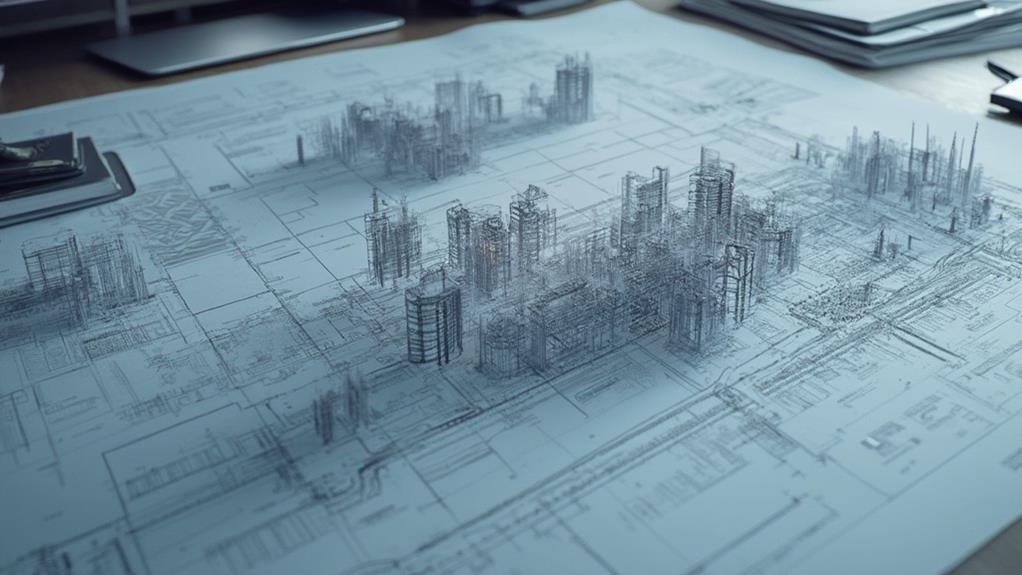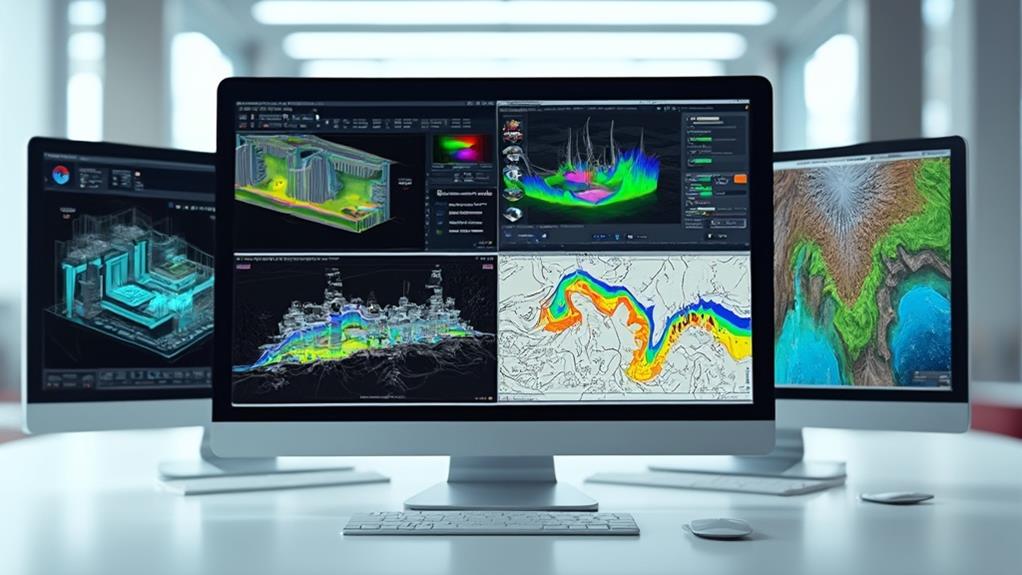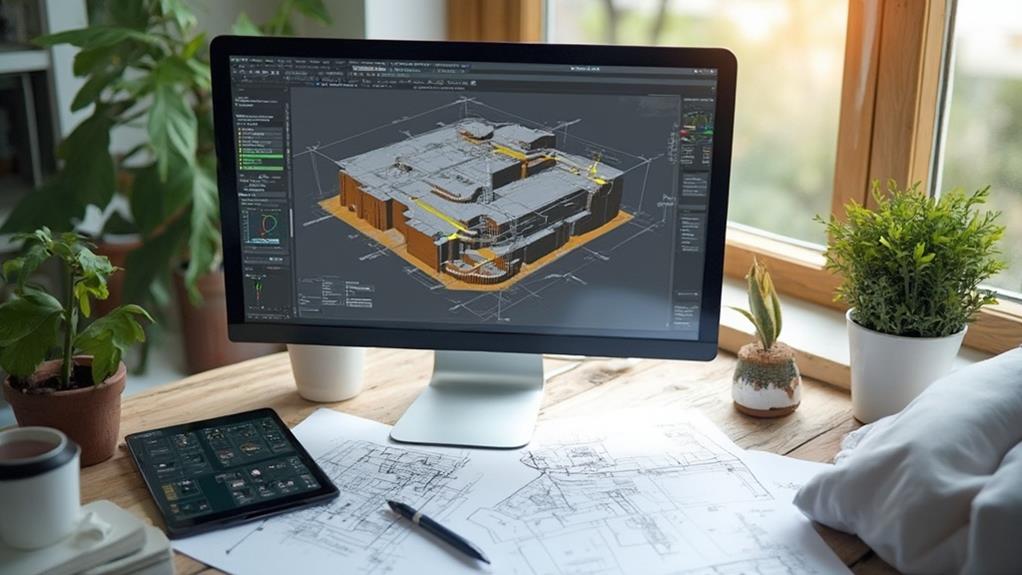Selecting the right retaining wall engineering software involves evaluating specific needs such as project scale, site conditions, and required features like soil-structure interaction models and load analysis. Opt for software that aligns with your project's complexity, offering both general-purpose capabilities and specialized functions for tasks like stability analysis and 3D modeling. Prioritize user-friendly interfaces with thorough tutorials to guarantee ease of use and productivity. Verify the software complies with regional regulations and industry standards while supporting efficient collaboration and resource optimization. Assess user reviews for insights on performance, stability, and usability to inform a decision that maximizes engineering outcomes. Exploring these aspects will provide further clarity.
Table of Contents
ToggleWalls Contractor Highlights
- Ensure software aligns with project-specific demands and site conditions for precise outcomes.
- Look for comprehensive geotechnical data integration to accurately predict ground behavior.
- Evaluate user-friendly interfaces with minimal learning curve to enhance productivity.
- Prioritize software that meets regional building codes and industry standards for compliance.
- Consider customization options for unique project requirements and local practices.
Definition of Retaining Wall Software

Retaining wall software is an essential tool for engineers, providing a robust platform for designing, analyzing, and simulating the intricate structures needed to prevent soil erosion and manage land stability. By integrating key features such as static and dynamic load calculations, soil-structure interaction models, and pre-built design templates, these software solutions cater to a variety of project scales and complexities.
For professionals like those at Boulder Walls, who specialize in building custom retaining walls, such software can be invaluable in ensuring structural integrity and weatherproofing. These tools can also assist in planning shoreline restoration projects and leveling sloping terrain for homeowners.
Additionally, different types of retaining wall software exist to meet industry-specific requirements, ranging from general-purpose engineering applications to specialized platforms for geotechnical and civil engineering domains, ensuring that professionals can select the most relevant tools for their unique challenges.
Key Features Overview
When it comes to developing effective retaining wall structures, engineering software plays a pivotal role in guaranteeing precision and efficiency. Recognizing the importance of these digital tools, a comprehensive understanding of key features is indispensable for professionals seeking to enhance their design and analysis capabilities.
Retaining wall engineering software simplifies complex calculations, offers intuitive user interfaces, and fosters seamless collaboration across project teams, thus guaranteeing successful outcomes.
Key features often found in these specialized tools include:
- Structural Analysis and Design: The software enables engineers to conduct detailed analyses, taking into account various forces and loads that walls must withstand, thereby ensuring structural integrity and safety.
- Geotechnical Integration: Effective software offers integration with geotechnical data, allowing for more accurate predictions of ground behavior, and subsequently ideal design adjustments to accommodate these conditions.
- 3D Modeling and Visualization: Advanced visualization tools allow for comprehensive 3D modeling, which is instrumental in simulating real-world conditions and facilitating better communication of design intent across teams.
Choosing software with these features can considerably enhance professionals' abilities to tackle complex retaining wall projects while fostering a collaborative work environment. Embracing technology that combines rigorous analysis with intuitive interfaces guarantees that project goals are met efficiently and effectively, cementing a sense of belonging within a community dedicated to innovative engineering solutions.
Types of Software
Traveling the expansive domain of engineering solutions, comprehending the varieties of retaining wall software becomes an essential aspect for professionals aspiring to select the appropriate tools for their projects. Within this field, understanding the subtleties of the different available software types is crucial, as each offers distinct functionalities that cater to varied engineering needs.
Primarily, retaining wall software can be categorized into two main types: general-purpose design software and specialized retaining wall software.
General-purpose design software provides a broad set of tools that allow engineers to conceptualize, model, and analyze different structural projects, including retaining walls. These solutions offer versatility and integration capabilities with other design systems, serving as a comprehensive tool for multidimensional engineering applications.
In contrast, specialized retaining wall software is tailored specifically for the modeling and analysis of retaining wall structures. This type delivers targeted features such as soil interaction modeling, stability analysis, and load-bearing assessments.
Choosing between these software types requires an understanding of project-specific demands. Software selection should align with the intricacies of the site conditions and the specific engineering objectives. Accordingly, familiarity with these types aids professionals in building resilient structures with refined efficiency and precision, fostering a sense of competence and inclusion within the engineering community.
Industry-Specific Requirements
Understanding the industry-specific requirements in retaining wall engineering necessitates precise knowledge of the software tools available. Choosing the right software involves knowing how these digital solutions align with the distinct demands of structural design and analysis. Tailored tools empower engineers to create designs that are not only efficient but also compliant with regional building codes and industry standards. In this regard, retaining wall software plays a pivotal role by providing simulation capabilities for earth pressure, stability analysis, and material specifications.
To guarantee the software meets the needs of a specific project or firm, it should possess the following attributes:
- Customization Options: The software should allow for adjustments and personalization to accommodate unique project requirements and local engineering practices.
- User-Friendliness: Engineers benefit from intuitive interfaces that reduce the learning curve and enhance productivity, thereby facilitating better team collaboration.
- Comprehensive Reporting: Robust reporting features guarantee all design aspects are documented, fostering transparency and ease of communication across stakeholders.
Incorporating these attributes into your selection criteria will align your software choice with the intricate demands of retaining wall projects, verifying you are equipped to deliver innovative and safe infrastructure solutions.
Benefits

Selecting the right retaining wall engineering software offers significant advantages that can greatly impact project outcomes. By improving project efficiency, such software enables engineers to perform accurate design calculations rapidly, thereby optimizing resource allocation and reducing the likelihood of costly errors.
These programs can also help in the design of boulder walls, which are versatile landscape elements used for retaining, landscaping, and erosion control. Additionally, these programs often feature cost-effective solutions and intuitive user-friendly interfaces, which streamline processes and make complex tasks approachable even for less experienced users, ultimately leading to more reliable and sustainable design implementations.
Enhancing Project Efficiency
Retaining wall engineering software serves as a catalyst for enhancing project efficiency by streamlining design processes and minimizing manual errors. In an industry where precision and timeliness are paramount, such software stands as an indispensable tool. By achieving coherence among various project facets, it assists engineers and stakeholders in orchestrating seamless workflows and fostering a connected environment. Essentially, the software eliminates redundant tasks, freeing professionals to focus on more strategic elements of design and implementation.
When evaluating software options, consider these avenues for fostering efficiency:
- Automation of Routine Tasks: By automating repetitive tasks, the software allows engineers to devote more energy to innovation and problem-solving, reducing the cognitive load and enhancing productivity.
- Collaboration Features: Integration with project management tools promotes collaboration among team members, facilitating efficient communication and ensuring that each phase of the project aligns with predefined objectives.
- Resource Optimization: The software optimizes resource allocation, thereby ensuring that materials and human resources are utilized effectively, reducing waste and keeping projects within budget constraints.
Accurate Design Calculations
Accurate design calculations serve as a cornerstone in the engineering of retaining walls, guaranteeing both safety and compliance with industry standards. When selecting retaining wall engineering software, the ability to deliver precise calculations stands paramount, bolstering confidence within the engineering community while fostering a sense of trust among stakeholders. Precision in calculations not only safeguards structural integrity but also aids in optimizing material usage, a critical factor for maintaining project feasibility and sustainability.
The software must accommodate various forces acting on retaining walls, including soil pressure, surcharge loads, and potential hydrostatic pressure, necessitating robust computational algorithms. This technical capability minimizes errors that might arise from manual calculations, thereby preemptively addressing potential design failures. By doing so, engineers can ensure that their projects meet stringent regulatory benchmarks, aligning with the broader objectives of industry adherence.
Furthermore, a software system providing accurate computations enables engineers to readily test and refine various design scenarios, fostering innovation within a collaborative working environment. Such precision tools cultivate a professional milieu where engineers align with shared goals of excellence and reliability. Consequently, selecting the right software elevates not only individual projects but also the collective ethos of engineering advancement.
Cost-Effective Solutions
Investments in retaining wall engineering software that offer cost-effective solutions extend beyond mere budget-friendly metrics. These investments facilitate extensive benefits that encapsulate both organizational and structural efficiencies, strategically empowering engineering teams while aligning financial constraints with project objectives.
By integrating seamlessly into existing workflows, efficient software reduces the scope of project overruns, ensuring economic prudence is achieved without sacrificing performance reliability or innovative potential.
Key benefits of opting for cost-effective retaining wall engineering software include:
- Enhanced Resource Allocation: Through optimized scheduling and resource management, teams experience improved coordination, minimizing waste and maximizing productivity.
- Competitive Edge: Affordably priced software enables firms to remain competitive, offering top-tier engineering solutions that adhere to budgetary demands without compromising quality or design integrity.
- Scalability: Such proficient programs provide scalable solutions adaptable to a variety of project sizes and requirements, allowing an organization to grow and adjust along with its client base and industry trends.
Ultimately, selecting software that prioritizes cost-effectiveness builds a foundation for sustainable project management, cultivating an environment wherein teams can thrive collaboratively towards shared objectives. By prioritizing these solutions, firms not only align with fiscal responsibility but also foster a sense of community and shared mission among their members.
User-Friendly Interfaces
Traversing complex retaining wall engineering systems becomes considerably more manageable with user-friendly interfaces. These intuitive software designs streamline the process, facilitating a deeper connection with the technology by minimizing the learning curve.
User-friendly interfaces contribute to a cohesive and inclusive work environment, where both seasoned engineers and newcomers can efficiently collaborate. This design approach guarantees that essential functions are easily accessible, offering clarity and reducing the chances of costly errors, which ultimately reinforces the sense of belonging among team members as they work harmoniously towards common goals.
The benefits of user-friendly interfaces in retaining wall engineering software extend beyond ease of use. A well-structured graphical user interface, for instance, often includes visual aids such as drag-and-drop functionalities and real-time data presentations, which enhance the comprehensibility of complex designs.
Furthermore, customizable dashboards allow users to tailor the interface to align with their specific needs, contributing to a more personalized and effective user experience. As a result, teams can focus on optimizing design processes and improving project outcomes, rather than grappling with cumbersome systems.
Ultimately, when selecting engineering software, considering the interface's accessibility can profoundly influence efficiency and team dynamics, fostering a collaborative and progressive professional atmosphere.
User Reviews and Ratings

In selecting the ideal retaining wall engineering software, user reviews and ratings provide vital insights into the comparative advantages of different platforms, particularly regarding feature set efficiency, performance reliability, and user interface simplicity. By analyzing firsthand user experiences, potential buyers can better gauge the true capabilities of each software option, beyond what is marketed by the developers. The table below highlights key aspects from user reviews that can influence your decision-making process:
| Aspect | User Feedback Summary |
|---|---|
| Feature Comparison | Highlights robust feature sets; identifies gaps |
| Performance and Stability | Consistent performance reports; notes occasional glitches |
| Ease of Use Evaluation | Generally intuitive interfaces; some learning curves |
Feature Comparison Insights
When selecting retaining wall engineering software, user reviews and ratings play an essential role in evaluating the suitability and performance of different options. These insights reflect authentic experiences from real-world users, providing potential customers with a clearer perspective on the software's strengths and weaknesses. Engaging with these reviews offers users a sense of community, allowing them to feel connected with peers who share similar challenges and aspirations in the field of engineering. Being well-informed about these experiences is indispensable to making a choice that complements both individual project requirements and personal preferences.
While exploring user reviews, it becomes imperative to focus on critical features that differentiate software packages. This helps in identifying which software aligns best with specific needs:
- User Interface: Reviews often highlight the usability and intuitiveness of the software, revealing ease of navigation and accessibility of tools.
- Technical Support: Feedback frequently mentions the quality and availability of customer support, indicating the likelihood of a satisfactory problem-resolution experience.
- Customization Options: Many engineers appreciate software that allows for tailored solutions to fit unique project demands, a feature often detailed in user testimonials.
Performance and Stability
As potential users investigate the nuances of retaining wall engineering software, attention naturally turns to the domains of performance and stability. These facets are critically underscored by user reviews and ratings, offering a glimpse into the software's real-world functionality.
In the engineering field, performance encapsulates the speed, efficiency, and responsiveness of the software when tasked with complex calculations and simulations. Stability, meanwhile, refers to the software's resistance to crashes, unexpected errors, or data losses, all of which are paramount when dealing with intricate engineering designs.
User reviews serve as a compass guiding potential buyers through the plethora of available options, highlighting those tools which consistently deliver high-grade performance with minimal technical disruptions. Ratings, often aggregated from diverse industry professionals, provide a quantitative measure of satisfaction, shedding light on software that meets or surpasses expectations in critical areas of performance and stability. Testimonials from peers not only lend credibility but foster a sense of community, where shared experiences contribute to informed decision-making.
As engineers seek software that seamlessly integrates into their workflow, they prioritize tools that not only inspire confidence but also stand the test of rigorous professional demands.
Ease of Use Evaluation
A critical factor in the evaluation of retaining wall engineering software is its user-friendliness, an aspect that can substantially enhance or impede productivity in the professional setting. The simplicity or complexity of a software interface influences not only the time taken to accomplish tasks but also the ease with which new users can be onboarded and adapt to the tool. User reviews and ratings serve as a crucial resource in judging the usability of such software, providing insight directly from those who engage with it daily.
To gauge ease of use, consider the following aspects as highlighted in user feedback:
- Intuitive Navigation: Users frequently commend software with straightforward, logical interfaces that allow for effortless access to essential features and tools.
- Learnability: Software that includes thorough tutorials and guides significantly aids new users in getting up to speed, reducing the learning curve.
- Efficiency in Task Execution: The capability of the software to facilitate swift completion of tasks without excessive complexity often correlates with higher productivity levels.
Walls Contractor FAQ
What Key Features Should I Look for in Retaining Wall Engineering Software?
When evaluating retaining wall engineering software, prioritize features such as intuitive user interface, thorough analysis tools, compatibility with industry standards, material customization, reliable technical support, and integration capabilities to guarantee seamless collaboration and accuracy in your engineering projects.
How Do I Determine Software Compatibility With My Existing Tools and Systems?
To determine software compatibility with existing tools and systems, conduct thorough reviews of technical requirements, seek feedback from current users, and consult with IT specialists to guarantee seamless integration, enhancing productivity and team cohesion within your organization.
What Are the Cost Considerations When Purchasing Retaining Wall Engineering Software?
When evaluating the cost of engineering software, consider initial purchase price, subscription fees, and potential integration expenses. Prioritize software offering value through reliable support and updates, ensuring long-term benefits and seamless adaptation to evolving project needs.
Are There Any Training Requirements for Optimal Use of Retaining Wall Software?
Training is essential for proficient utilization of retaining wall software, facilitating accurate analysis and design. Engaging in thorough training fosters skills enhancement, ensuring team alignment and elevating project execution efficiency within the engineering community.
How Do Updates and Support Services Influence Long-Term Software Effectiveness?
Updates and support services greatly enhance long-term software effectiveness by ensuring it remains relevant, bug-free, and compliant with industry standards. A reliable support network fosters community engagement, assuring users of a committed partnership and continuous improvement.







